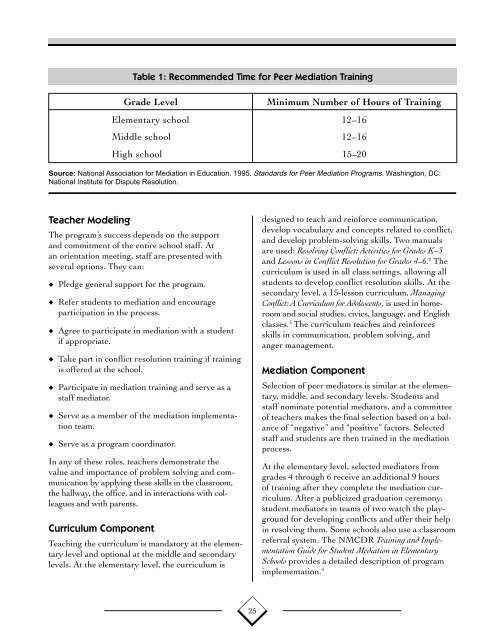Conflict Resolution Education - National Criminal Justice Reference ...
Conflict Resolution Education - National Criminal Justice Reference ...
Conflict Resolution Education - National Criminal Justice Reference ...
Create successful ePaper yourself
Turn your PDF publications into a flip-book with our unique Google optimized e-Paper software.
Teacher Modeling<br />
The program’s success depends on the support<br />
and commitment of the entire school staff. At<br />
an orientation meeting, staff are presented with<br />
several options. They can:<br />
♦ Pledge general support for the program.<br />
♦ Refer students to mediation and encourage<br />
participation in the process.<br />
♦ Agree to participate in mediation with a student<br />
if appropriate.<br />
♦ Take part in conflict resolution training if training<br />
is offered at the school.<br />
♦ Participate in mediation training and serve as a<br />
staff mediator.<br />
♦ Serve as a member of the mediation implementation<br />
team.<br />
♦ Serve as a program coordinator.<br />
Table 1: Recommended Time for Peer Mediation Training<br />
Grade Level Minimum Number of Hours of Training<br />
Elementary school 12–16<br />
Middle school 12–16<br />
High school 15–20<br />
Source: <strong>National</strong> Association for Mediation in <strong>Education</strong>. 1995. Standards for Peer Mediation Programs. Washington, DC:<br />
<strong>National</strong> Institute for Dispute <strong>Resolution</strong>.<br />
In any of these roles, teachers demonstrate the<br />
value and importance of problem solving and communication<br />
by applying these skills in the classroom,<br />
the hallway, the office, and in interactions with colleagues<br />
and with parents.<br />
Curriculum Component<br />
Teaching the curriculum is mandatory at the elementary<br />
level and optional at the middle and secondary<br />
levels. At the elementary level, the curriculum is<br />
25<br />
designed to teach and reinforce communication,<br />
develop vocabulary and concepts related to conflict,<br />
and develop problem-solving skills. Two manuals<br />
are used: Resolving <strong>Conflict</strong>: Activities for Grades K–3<br />
and Lessons in <strong>Conflict</strong> <strong>Resolution</strong> for Grades 4–6. 2 The<br />
curriculum is used in all class settings, allowing all<br />
students to develop conflict resolution skills. At the<br />
secondary level, a 15-lesson curriculum, Managing<br />
<strong>Conflict</strong>: A Curriculum for Adolescents, is used in homeroom<br />
and social studies, civics, language, and English<br />
classes. 3 The curriculum teaches and reinforces<br />
skills in communication, problem solving, and<br />
anger management.<br />
Mediation Component<br />
Selection of peer mediators is similar at the elementary,<br />
middle, and secondary levels. Students and<br />
staff nominate potential mediators, and a committee<br />
of teachers makes the final selection based on a balance<br />
of “negative” and “positive” factors. Selected<br />
staff and students are then trained in the mediation<br />
process.<br />
At the elementary level, selected mediators from<br />
grades 4 through 6 receive an additional 9 hours<br />
of training after they complete the mediation curriculum.<br />
After a publicized graduation ceremony,<br />
student mediators in teams of two watch the playground<br />
for developing conflicts and offer their help<br />
in resolving them. Some schools also use a classroom<br />
referral system. The NMCDR Training and Implementation<br />
Guide for Student Mediation in Elementary<br />
Schools provides a detailed description of program<br />
implementation. 4

















